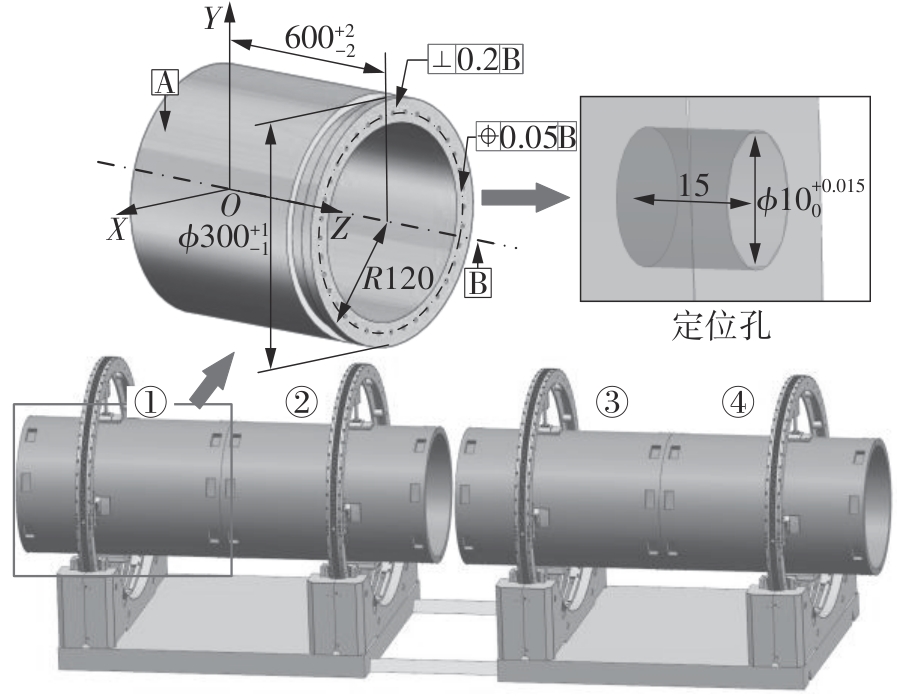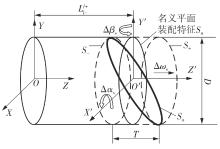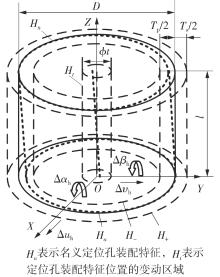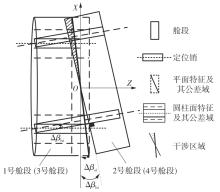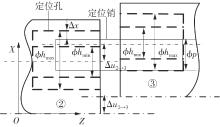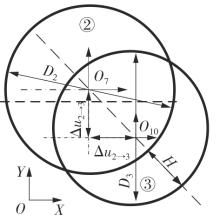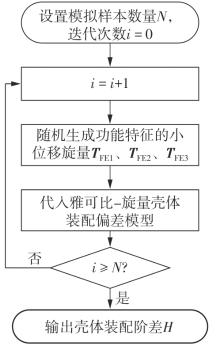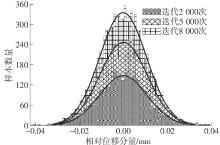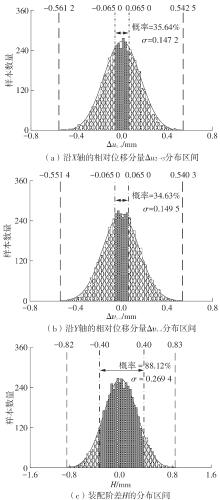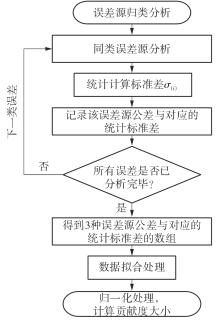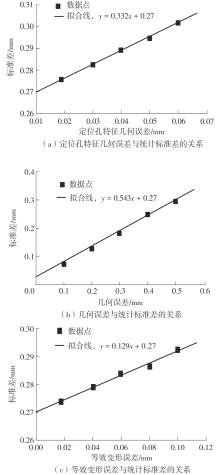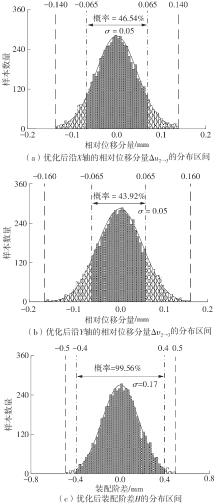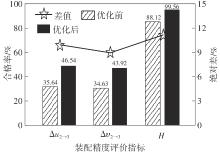| 1 |
吴伟,邓准,尚建忠,等 .精密光机系统多敏感轴装配精度分析与装配工艺优化[J].农业机械学报,2021,52(4):418-426.
|
|
WU Wei, DENG Zhun, SHANG Jianzhong,et al .Assembly accuracy analysis and process optimization of multi-sensitive axes for precision optical mechanical system[J].Transactions of the Chinese Society for Agricultural Machinery,2021,52(4):418-426.
|
| 2 |
李世其,陈栋,王峻峰,等 .面向并联机构的舱段自动对接方法[J].华中科技大学学报(自然科学版),2020,48(10):31-37.
|
|
LI Shiqi, CHEN Dong, WANG Junfeng,et al .Automatic docking method of cabins with parallel mechanism [J].Journal of Huazhong University of Science and Technology (Natural Science Edition),2020,48(10):31-37.
|
| 3 |
苏裕林,刘浩,苏琦,等 .统一计算架构下的装配精度并行计算模型[J].西安交通大学学报,2023,57(6):105-114.
|
|
SU Yulin, LIU Hao, SU Qi,et al .Assembly accuracy parallel computing model under unified computing architecture[J].Journal of Xi’an Jiaotong University,2023,57(6):105-114.
|
| 4 |
DING S, JIN S, LI Z,et al .Multistage rotational optimization using unified Jacobian-Torsor model in aero-engine assembly[J].Proceedings of the Institution of Mechanical Engineers,Part B:Journal of Engineering,2019,233(1):251-266.
|
| 5 |
邓王倩,莫蓉,陈凯,等 .基于实测数据的航空发动机转子叶尖装配间隙预测[J].航空动力学报,2022,37(6):1273-1283.
|
|
DENG Wangqian, MO Rong, CHEN Kai,et al .Prediction of rotor blade tip assembly clearance based on measured data for aero-engine[J].Journal of Aerospace Power,2022,37(6):1273-1283.
|
| 6 |
MU X, WANG Y, YUAN B .A new assembly precision prediction method of aeroengine high-pressure rotor system considering manufacturing error and deformation of parts[J].Journal of Manufacturing Systems,2021,61:112-124.
|
| 7 |
JIN S, DING S, LI Z,et al .Point-based solution using Jacobian-Torsor theory into partial parallel chains for revolving components assembly[J].Journal of Manufacturing Systems,2018,46(2018):46-58.
|
| 8 |
戴宏玮,陈琨,于慧,等 .雅可比旋量的装配体并联结构公差分析方法研究[J].西安交通大学学报,2022,56(5):156-165,222.
|
|
DAI Hongwei, CHEN Kun, YU Hui,et al .Research on the tolerance analysis method of assembly parallel structure based on Jacobian spinner[J].Journal of Xi’an Jiaotong University,2022,56(5):156-165,222.
|
| 9 |
YANG Z, YANG W, GAO T,et al .Tolerance analysis method considering multifactor coupling based on the Jacobian-Torsor model[J].Advances in Mechanical Engineering,2022,14(12):16878132221140215/1-13.
|
| 10 |
DING S, ZHENG X .Variation analysis considering the partial parallel connection in aero-engine rotor assembly[J].Energies,2022,15(12):4451/1-23.
|
| 11 |
TIAN A, LIU S, CHEN K,et al .Spatial expression of assembly geometric errors for multi-axis machine tool based on kinematic Jacobian-Torsor model[J].Chinese Journal of Mechanical Engineering,2023,36(1):44/1-15.
|
| 12 |
MA S, HU K, HU T,et al .Two improved assembly deviation analysis methods based on Jacobian-Torsor matrix and skin model shapes with contact deformation effort[J].Proceedings of the Institution of Mechanical Engineers,Part B:Journal of Engineering Manufacture,2023:09544054231184285.
|
| 13 |
钱鹏,王国亮,朱文峰 .柔性变形下车窗升降三维装配公差建模及优化[J].上海交通大学学报,2020,54(11):1134-1141.
|
|
QIAN Peng, WANG Guoliang, ZHU Wenfeng .Modeling and optimization of three-dimensional assembly tolerances for window lifting under flexible deformation[J].Journal of Shanghai Jiaotong University,2020,54(11):1134-1141.
|
| 14 |
荆涛,田锡天 .基于蒙特卡洛-自适应差分进化算法的飞机容差分配多目标优化方法[J].航空学报,2022,43(3):577-588.
|
|
JING Tao, TIAN Xitian .Multi-objective optimization method for aircraft tolerance allocation based on Monte Carlo-adaptive differential evolution algorithm[J].Acta Aeronautica et Astronautica Sinica,2022,43(3):577-588.
|
| 15 |
MIAH M H, ZHANG J, CHAND D .Knowledge creation and application of optimal tolerance distribution method for aircraft product assembly[J].Aircraft Engineering and Aerospace Technology,2022,94(3):431-436.
|
| 16 |
马宁,杨波,刘彦超,等 .基于配合约束的几何公差分配方法[J].计算机集成制造系统,2023,29(1):296-309.
|
|
MA Ning, YANG Bo, LIU Yanchao,et al .Geometric tolerance allocation method based on fit constraints [J].Computer Integrated Manufacturing Systems,2023,29(1):296-309.
|
| 17 |
FAN J, TAO H, CHEN D .Optimal Tolerance allocation for five-axis machine tools in consideration of deformation caused by gravity[J].International Journal of Advanced Manufacturing Technology,2020,111(1):13-24.
|
| 18 |
吴翰林,魏沛堂,蔡磊,等 .基于加工误差敏感度与模糊层次分析法的行星滚柱丝杠公差匹配优化方法[J].中国机械工程,2022,33(22):2693-2703.
|
|
WU Hanlin, WEI Peitang, CAI Lei,et al .Optimization of planetary roller screw tolerance matching based on machining error sensitivity analysis and fuzzy analytic hierarchy processes[J].China Mechanical Engineering,2022,33(22):2693-2703.
|
| 19 |
WANG X, CAO Z, SUN C,et al .Positioning and orientation error measurement and assembly coaxiality optimization in rotors with curvic couplings[J].Measurement,2021,186:110167/1-12.
|
| 20 |
杜海雷,孙惠斌,黄健,等 .面向装配精度的航空发动机转子零件选配优化[J].计算机集成制造系统,2021,27(05):1292-1299.
|
|
DU Hailei, SUN Huibin, HUANG Jian,et al .Optimization of aeroengine rotor parts selection for assembly accuracy[J].Computer Integrated Manufacturing Systems,2021,27(5):1292-1299.
|
| 21 |
WANG B, HUANG X, CHANG M .Reliability-based tolerance redesign of mechanical assemblies using Jacobian-Torsor model[J].Science Progress,2021,104(2):1-13.
|
| 22 |
张辉,潘新,于传军 .飞机舱门装配容差分析与优化方法[J].制造业自动化,2023,45(8):119-122,140.
|
|
ZHANG Hui, PAN Xin, YU Chuanjun .Tolerance analysis and optimization method of aircraft door assembly[J].Manufacturing Automation,2023,45(8):119-122,140.
|
| 23 |
张为民,李国伟,陈灿 .基于雅可比旋量理论的公差优化分配[J].农业机械学报,2011,42(4):216-219,228.
|
|
ZHANG Weimin, LI Guowei, CHEN Can .Optimal allocation of tolerance based on Jacobian-torsor theory [J].Transactions of the Chinese Society for Agricultural Machinery,2011,42(4):216-219,228.
|

